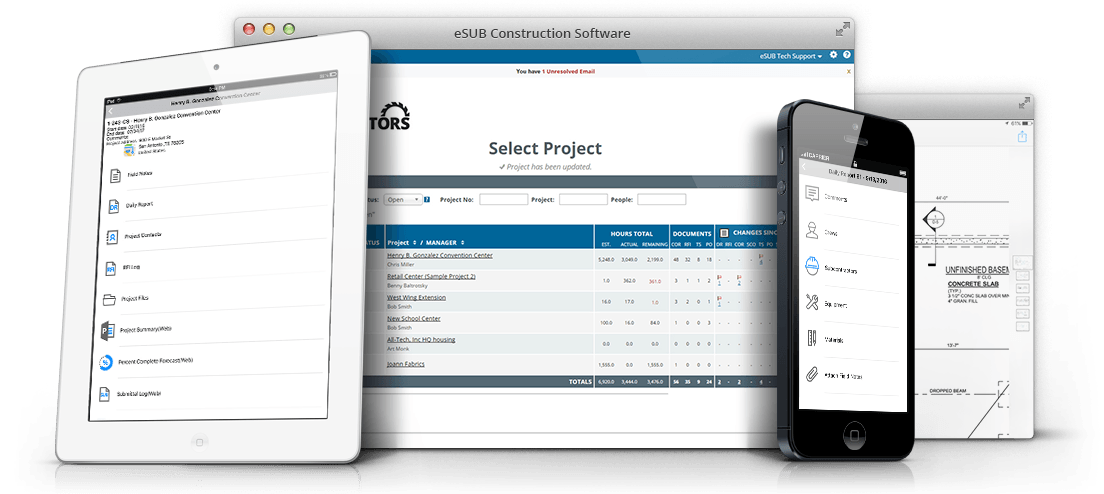
Increase ROI with Mobile & Cloud-Based Project Management Software
Increase Revenue and Reduce Costs by Connecting the Field and Office
Keeping up to date on current projects has been a thorn in the side of many contractors. Communication is the key to success in any construction project, and with today’s technology, it has never been easier. Mobile and Cloud-based solutions, accessible from anywhere, allow team members to enter standardized data, site events, labor activities, material costs, workforce information and more into a fully searchable database updated in real-time.
This means no more tracking in separate Excel spreadsheets or Word documents, missing information and unnecessary mistakes. The result is increased project organization, delivery and profit resulting in the successful completion of a project. Often, a project failure is due to lack of communication and collaboration among the project team(s).
One road block to seamless communication between the project team(s), is the silos created between architects, general contractors and subcontractors. Traditionally, if the subcontractor has a question, they approach the contractor, who then submits an RFI to the architect, who then requests clarification from a consultant. The answer follows the reverse route back to the subcontractor, resulting in delays and teams working with incorrect or outdated information.
Table of Contents
Challenges & Solutions
Too much information to manage with current methods. Traditional methods, such as email, Microsoft Excel spreadsheets and FTP file transfers, are not sufficient for the sheer volume of data, drawings, RFI responses, submittals, etc., that team members are expected to manage and share. Keeping up with the data manually is a never-ending struggle.
Solution: Implement a cloud-based system to house all of the data in a centralized location that every team member can access, 24/7, via a computer or mobile device on an as-needed basis.
No one likes siloed data. With so many cooks in the kitchen, documents are often duplicated within the offices of owners, general contractors, architects and subcontractors. Usually, these documents are out of sync which leads to team members having out-of-date information, resulting in increased project costs and rework.
Solution: Have one set of documents stored within the cloud allowing real-time updates and visibility to all appropriate project personnel. This leads to everyone being on the same page, which leads to accountability. The days of finger-pointing for project mishaps are over. Every team member sees the same up-to-date information regarding timelines, deliverables and RFIs, resulting in less downtime.
Disconnects between the office and the field. Things change rapidly and frequently on construction projects. If the field team is out of the loop on the information flow, then chances are they are either not working on what they should be working on, or they are doing something they shouldn’t be doing, which may need to be reworked. The field team is also constantly contacting the office for clarification on issues, instead of doing the work.
Solution: Utilize a cloud and mobile solution. This means being able to push updates out to the team(s) and vice-a-versa as soon as changes are made. This almost entirely reduces communication latency and helps prevent potentially wasteful situations. Cloud and mobile technologies facilitate the contractor’s goals to increase revenue and reduce costs per project. By storing information in the cloud, the entire team gains a “single source of truth” connecting all the project data—from the master schedule and weekly work plan to quality checklists and the most up-to-date documents.

Best Practice Tips
- Document everything—right away. Construction customers are demanding proof before they pay, so it’s crucial to adequately document to get paid on that change order. Even routine work must be documented so that timed invoices can be generated. The closer to real time that something is documented, the faster that milestones achieved which can turn into invoices sent—thus shortening the time to cash.
- Eliminate spreadsheets. No amount of exclamation points would emphasize this key point enough for the firms who have made the move and get its value. Intricate, elaborate spreadsheets may get the job done, but spreadsheets are the enemy of information visibility. One undetected error can destroy an analysis. Spreadsheets cannot make the information flow from estimating to project management to accounting/payroll, or to owners in ways that make it instantly actionable to the stakeholders at each of those steps.
- Exploit the value of seamless information sharing. Information access and visibility are used in a number of ways to create value. Implemented properly, nobody has to rekey information multiple times. It enhances estimating and project management processes as discussed, but it also empowers finance and accounting processes. For example, it can dramatically reduce the time needed to perform functions like certified payroll reports and billing. Perhaps most importantly, it provides executives with the visibility they need to effectively control every important aspect of firm operations.
- Accessible information, but permission driven . While the value of making information shareable is irrefutable, that does not mean share and share alike. Some information is proprietary. Carefully configure systems so that everyone who needs to know, knows—but also secure the information so that only the appropriate parties see it.
- Finally, there’s something for the field: mobile access. Connecting the field to the office through cloud-based technology and mobile applications is a must. It enables your team to document and update project data from anywhere in the field. For project team members, the ability to stay connected to stakeholders while on a jobsite can shave hours off the work schedule. And by not having to chase down contracts, insurance documents, RFls, change orders and the most current project plans, employees can keep the project moving forward while working in the field.